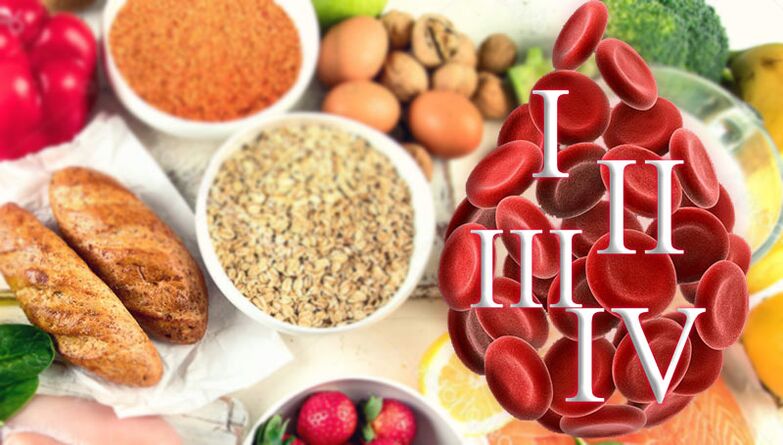The method of nutrition by blood groups was developed by the American doctor Peter D'Adamo. According to his theory, the digestibility of food, the efficiency of their use by the body is directly related to the genetic characteristics of a person. Namely, with his blood type. For the normal functioning of the immune and digestive systems, a person needs to eat foods that correspond to the blood group, that is, those that his ancestors ate in ancient times. Removing substances incompatible with the blood from the diet reduces slag in the body, improves the functioning of internal organs and promotes weight loss. Consumption of the same "foreign" products leads to slagging of the body and rapid growth of body fat.

The theory of nutrition by blood group has caused heated discussions among doctors, which have not died down so far. Based on D'Adamo's technique, various blood type diets have been developed, which have recently become very fashionable. How, according to D'Adamo, should people with different blood types eat?
Food according to the first blood group
People who have blood group 1 (0) and are called "hunters" should rely on animal protein, and they should refuse bread, pasta and dairy products.
Blood group 1 (0) is the oldest and most common. People of the first blood group are meat eaters with a persistent digestive tract, an overactive immune system and poor adaptation to new diets. The digestive tract of "hunters" has not yet adapted to dairy products and cereals.
Particularly useful products
Lean meat (lamb, beef), fish, salmon, cod, pike, olive oil, nuts, pumpkin seeds, beets, figs.
Foods that should be limited
Dairy products, cheeses, cottage cheese, fatty meats, in particular pork, pasta and other flour products, potatoes, strawberries, mandarins, oranges, melons, avocados, corn and peanut butter, olives.
Weight gainer foods
Wheat, corn, beans, beans, cabbage, cauliflower.
Weight loss foods
Red meat, liver, seafood.
Nutrition according to the second blood group
Representatives of the 2nd blood group (A) - "farmers" - are recommended for vegetarian food.
The emergence of blood group 2 (A) is associated with the transition of people to agriculture. The owners of the second blood group are vegetarians with a sensitive digestive tract. They need a natural and environmentally friendly diet. People of the second blood group should exclude meat from the diet: if in the body of "hunters" meat is burned as fuel, then in "farmers" it turns into fat. They also poorly assimilate dairy products. But "farmers" can eat a variety of natural, low-fat products, vegetables and grains.
Particularly useful products
Seafood in moderation, soybeans, beans, beans, buckwheat, rice, artichoke, Jerusalem artichoke, vegetable oils, soy products, vegetables and pineapple.
Foods that should be limited
Wheat bread, potatoes, apricots, cranberries, ketchup, mayonnaise. It is advisable to completely exclude meat and meat products from the diet.
Weight gainer foods
Meat, dairy products, beans, wheat.
Weight loss foods
Vegetable oils, soy products, vegetables, pineapples.
Nutrition according to the third blood group
Blood group 3 (B) arose when human tribes began to migrate north to a region with a harsh climate. Therefore, the owners of the third D'Adamo blood group call it "nomads". They have a strong immune system and can choose their food more freely than people with 1 and 2 blood types. The "nomads" are the main consumers of milk. A harmonious combination of physical and mental activity will help them maintain their shape and good mood.
Soybeans, chicken, sunflower oil, tomatoes and pomegranates are contraindicated in people of the third blood group; all dairy products, fish, lamb, rabbit meat and linseed oil are useful.
Particularly useful products
Lamb, rabbit, mackerel, cod, plaice, goat cheese, olive oil, oatmeal, rice, parsley, cabbage, pineapple, plums.
Foods that should be limited
Goose meat, chicken meat, beef, pork, heart, shrimp, anchovies, lobster, eel, sunflower, peanut and corn oil, buckwheat, rye bread, tomatoes, pomegranates, persimmons.
Weight gainer foods
Corn, lentils, peanuts, buckwheat, sesame seeds.
Weight loss foods
Red meat, liver, liver, low fat dairy products, green vegetables, eggs.
Nutrition according to the fourth blood group
Blood group 4 (AB) appeared less than a thousand years ago as a result of a mixture of other groups. Hence the name: "new people". People of the fourth blood group respond quickly to environmental and nutritional changes. They have a sensitive digestive tract and an overly tolerant immune system. The best way to stay in shape is to combine mental work with light physical activity.
The basis of nutrition for owners of the fourth blood group should be fat-free foods with sour milk, lamb, game, vegetables and fruits.
The set of extra pounds is influenced by mixed heredity. To lose weight, owners of 4 blood groups need to limit the consumption of meat, combine it with vegetables. B ancestor inheritance is a negative insulin reaction to beans, corn, buckwheat, and sesame seeds. But thanks to the A ancestors, their bodies accept lentils and peanuts well. Unlike both, AB people respond well to wheat.
Particularly useful products
Lamb, turkey meat, cod, mackerel, dairy products, corn oil, oatmeal, wheat bread, collard greens, cranberries, pineapple.
Foods that should be limited
Beef, bacon, duck, plaice, crab, salmon, whole milk, olive oil, pumpkin seeds, beans, buckwheat, radish, avocado, bananas, pomegranates.
Weight gainer foods
Red meat, beans, corn, buckwheat, wheat.
Weight loss foods
Seafood (except canned, dried, dried and smoked), soybeans, dairy products, green vegetables, pineapple.
a little conclusion
Above are the diet-specific foods of each blood group. However, each of us has our own individual characteristics. Therefore, when choosing food products, choosing a diet by blood group, one should take into account not only general recommendations, but also its individuality, first of all - the origin and blood group of ancestors.
Doctors have yet to come to a consensus on the effectiveness of blood group nutrition, although most nutritionists consider this theory to be at least valid. For people with chronic diseases, nutrition by blood group should be used with great caution, be sure to consult a doctor.






























